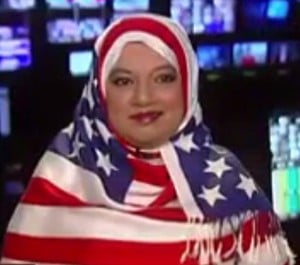Kecya Felix, a Brazilian stylist/designer, wore a fake Chanel niqab and abaya and an iPad around her neck which played “Could Coco Chanel Create This Look?” at Sao Paulo Fashion Week.

- Kecya Felix wearing the abaya.
As this article puts it, Felix intended to “make a statement” through the performance, wearing ”a fake Chanel Muslim garment” and, apparently, losing the ability to speak, (although her hearing remained unaffected):
I approached Felix to ask what she was all about. She shook her head and pointed towards her boyfriend, American Ryan Donnelly, who was functioning as her voice for the ever growing throngs of showgoers who stopped, intrigued, to find out more about Felix and her provocative outfit.
Remaining mute throughour her performance in her fake Chanel abaya, Felix explained later in an artistic statement written in the third person that her project is “about sexism in clothes”:
“Kecya traveled to the Middle East looking for references on that issue out there…she found a fake Chanel Muslim garment…which she considers controversial for the women’s expression in present days. She then decided to have an experience wearing the Islamic pieces–the fake Chanel niqab and abaya to create art performance.”
Part of what makes the abaya “controversial” is that for some people it would be considered unusual, the abaya as a “Muslim garment” seen as a signifier of anachronistic backwardness, juxtaposed with the interlocking CC of Coco Chanel – as the article asks: “did you know such a thing existed?” As someone who did know such a thing existed and who is familiar with these types of abayas in the context of everyday life, it was initialy disconcerting that this “garment” would be disconcerting enough that putting it on would be described as “having an experience.” That, and the mute-performance, brings to mind the experiences of women such as French journalist Elizabeth Alexandre who tried on niqab for a week for her article “Ma semaine en Niqab” (My Week in a Niqab) – essentially performing a niqabi woman by putting on the niqab.
The interlocking CC’s on a abaya do raise interesting questions about the intersections of fashion, sexism and religon. Why would women wear fake Chanel abayas? Why would this seem incongrous to some people? How does someone’s background affect how they react to this piece of clothing? The only question Felix seems to be asking however, is “Could Coco Chanel Create This Look?” Her question, like her statement, positions the abaya as a “garment” from “out there” – from a world outside the bounds of Chanel and Sao Paulo Fashion week. “Can it be brought into our world, without said world imploding?” the iPad Felix wears ponders.
The article asks its own questions, including: “Is a fake Chanel hijab degrading to women?” The discourse invoked is tied to a notion of freedom which assumes the “Muslim Other” to be repressed and guided by antiquated and oppressive gender norms. It reminds me of reactions to the picture of a Muslim girl with a mohawk-like hijab: She can’t show her hair, but she can show her punk soul!

The sentence positions the mohawk-hijab girl as the universal Muslim woman, constructed as a victim of dogmatic beliefs. The implication is that what she has been deprived of the right to be what she longs to be, and yet is doing her best to express herself within an oppressive environment. Admire her, or alternatively, think: this is sad/pathetic.
Before reading the reactions, my own reaction to the mohawk hijab was to see it as “making a statement” which equates the hijab with the mohawk along the lines of non-conformity, the unfamiliar and the unconventional sewn into one. Of course, what we think we already know determines what our reactions will be and my interpretation is just that: an interpretation. But, like the Chanel abaya, to me the mohawk hijab seemed to me a product of cosmopolitan culture, having to do with the creation a self-image through clothing in today’s hybridized world, and thus less incongruous than some would make it out to be.
What does seem incongruous to me is when that focus on incongruity is turned into an exercise in back-patting which pits the values of “freedom” against “Muslim culture” invoking binaries which have always been dysfunctional, which increasingly seem hopelessly outdated, and yet remain frustratingly persistent.














